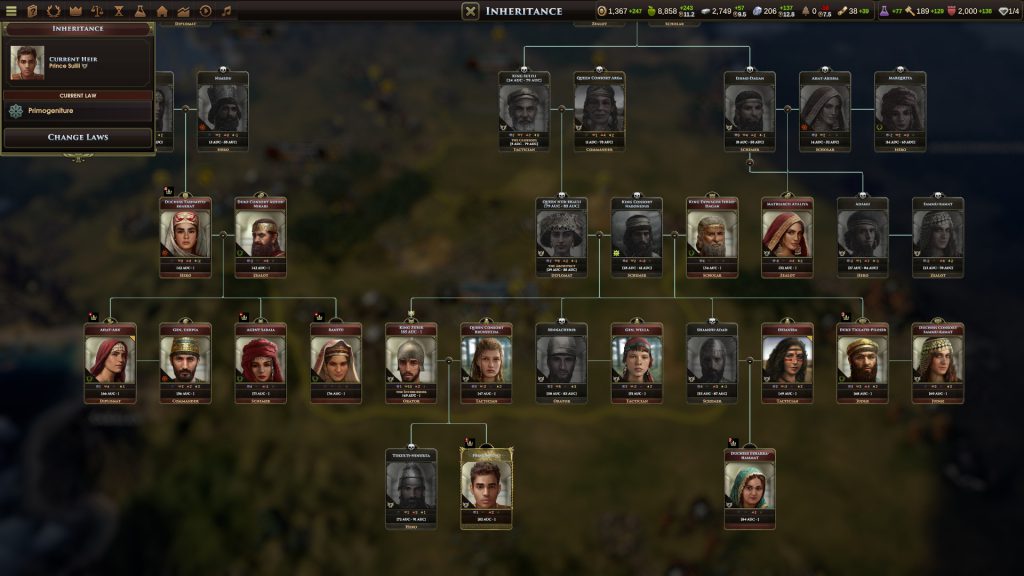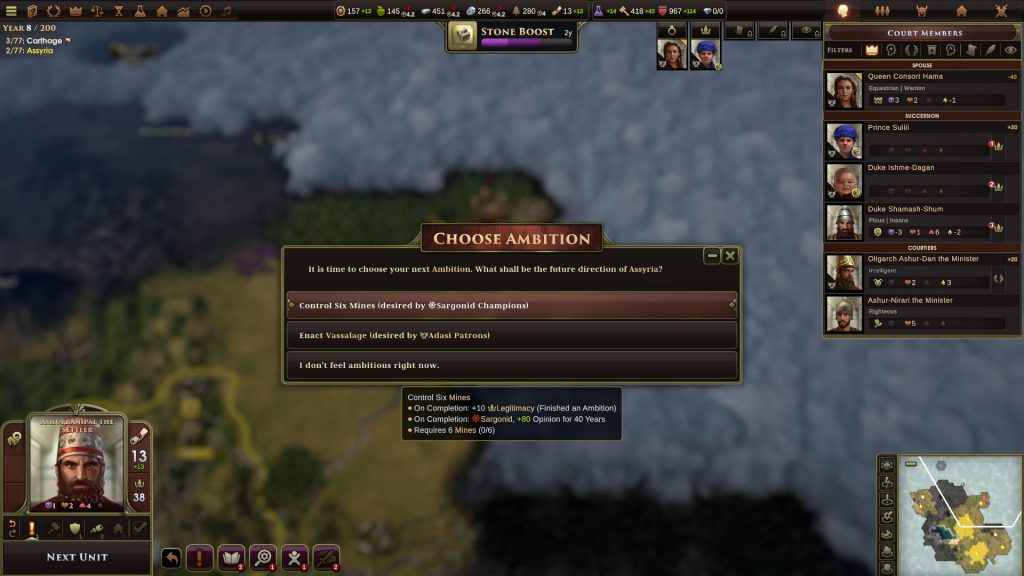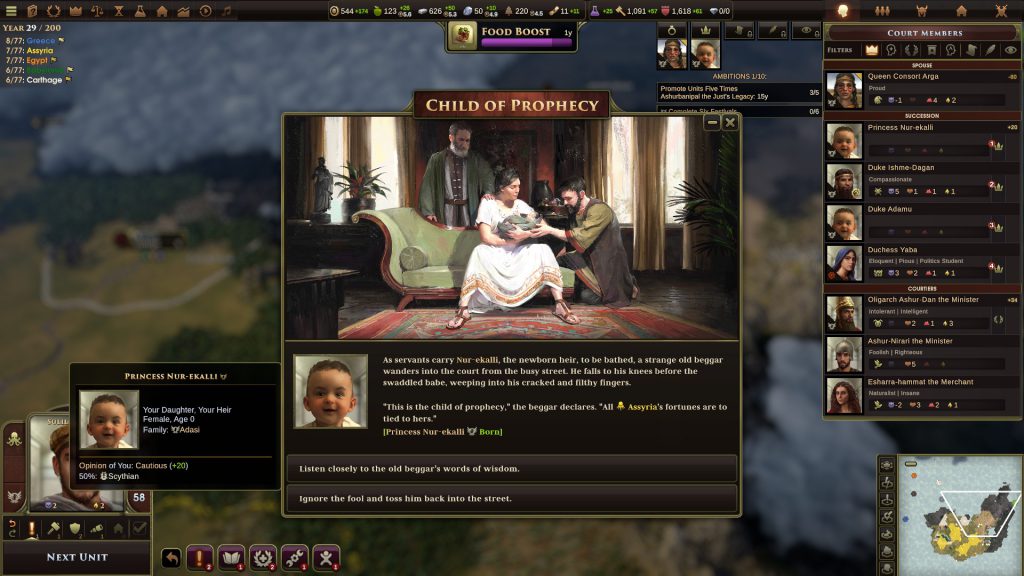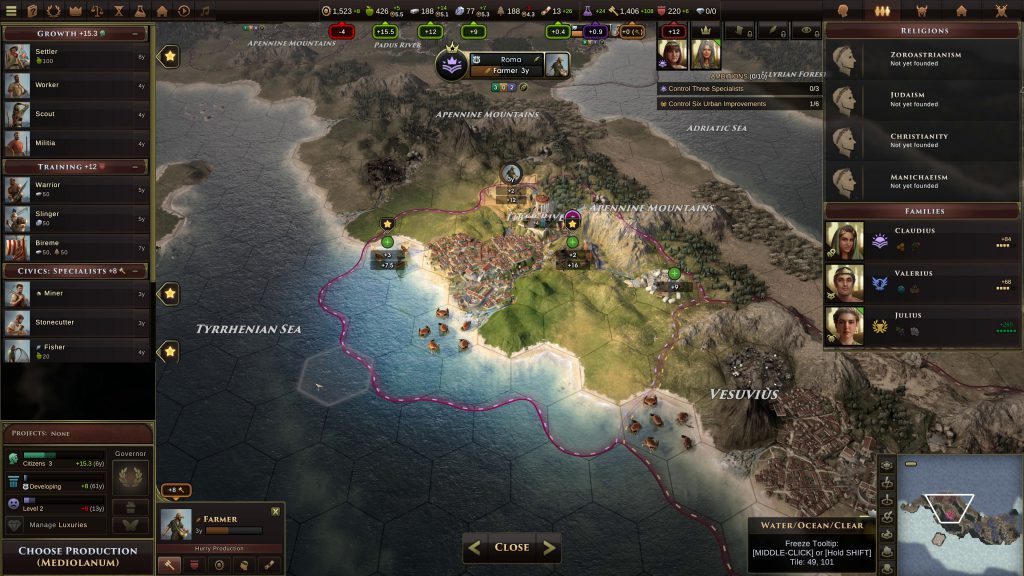Old World is brimming with both character and great new innovation for the 4X genre
A 4X historical game measured in generations rather than ages, Old World shows exactly how a tighter scope can allow for much more exciting and compelling mechanics and play.
It’s hard to talk about historical strategy, or 4X, games without the Civilization series being mentioned. It’s a long-running series that’s been inspiring, influencing and entertaining for years. Notably, though, several of its designers have gone on to create some pretty great games too, although they’re often a step away from the sweeping setting (Oh — I dunno, bronze age to space age) of Civ. That’s a good thing because by winding back the scope, as Old World has, and not having to stretch your setting through the ages you can create a better representation and focus more on the time period, or core concepts behind the game.
In the case of Old World, which comes from Mohawk Games (founded by Soren Johnson, Civ III co-lead designer and Civ IV lead designer), it focuses on some of the earliest civilisations, and of those, it only picks those who interacted with each other or overlapped in the same geographic area. Assyria, Babylonia, Carthage, Egypt, Greece, Persia and Rome are in as playable nations, while the likes of the Scythians, Vandals, Gauls and Celts are present as scattered (but somewhat united) tribes, with single-encampment barbarians making up the rest of the in-game forces. This does mean that nations like Media, Sumeria, Akkad, and Phoenecia are not included, however, there’s got to be a line drawn somewhere.
Old World will probably look incredibly familiar, and that’s perhaps its curse because, for all of the originality included in the game (honestly, there are stacks of it), most people will see the visuals and quickly imagine an intermarrying of Crusader Kings, Civilization and Rome: Imperator. They’re not wrong to do so, really, but this is definitely a case of the whole being greater than the sum of its parts. It’s got the character relations and unpredictability that come from an events system, with the historical, hex-based stylings of the recent Civilization games, but all of that is compressed and refined down into a 200-year, Classical-period window of time.
My first full game outside of the extremely robust tutorial campaign perhaps best explains how different it plays from any of the above. At turn 130 I was messing around with a, now, three-family strong Assyrian nation. I had agents in most of my rival’s capitals and had been in a 100 year-long, marriage-led state of peace with not only the Greeks, but also the Scythian tribes that not only served as a buffer around my cities but also filled the space between my nation and the major ocean to the South East. Occasionally, barbarian units would attack — at one point an event fired where the Scythian leader apologised and said they couldn’t keep everybody in line — but that was happening so infrequently that I just concentrated on trying to complete the ambitions (a player-exclusive victory route) that my rulers were being served up. I didn’t realise, around that point, that Greece and my almost-ally Egypt, had fallen down the score chart and that Carthage had climbed up to around half the score needed to be declared the winner at the close of the game. I looked outward from the networks of roads, hamlets and tile upgrades that I was carefully building and noticed that Carthage had been gobbling up the Scythian settlements around the outskirts of my territory, which left me bordering them to the North and the West.

Four turns later I was taking the coward’s route. I declared war on the wives and husbands of my forebearers and turned my back on the tribes. I tried to slide my army from one extreme of my empire to the other but didn’t have enough command power (represented in-game as Orders) and so, was left with an undefended Western City when all of a sudden, shock-horror, a rebellion struck. The family that were overseers of the city had lost faith in me, happiness had crashed, and rebels had risen. My troops were divided and a “simple” exercise against ‘barbarians’ became a thirty turn (of two-hundred, need I remind you) gruelling crawl through Scythian lands as I tried to wipe them out so that I could create a new heartland to fuel my nation in what would clearly be a rivalry to the finish-line against Carthage.
Because it’s all set in the earliest stages of civilization there are no sudden technology jumps as you push into new eras. 200 turns in Civilization takes you from axeman to around gunpowder (it’s about 1400AD) with all of the other technological advancements that come with it, that simply doesn’t happen in Old World, you’ll refine your armies by sliding in new units like chariots or spearmen; a late-game technology is square unit formations. This means that everything is much more careful, and deliberate, which is a great thread that runs throughout every moment of it.

It means that Old World feels like it’s the fourth or fifth entry in a long-running series or a game made by a team who comes from a whole spectrum of strategy game development backgrounds. The event and family system almost feel like a full, narrative game on its own; that’s before military, infrastructure and faction management come into things… that and religion, which plays out somewhat similar to other strategy games, however, has the extra wrinkle of the personal-relationships and leader-religions adding complication to interpersonal relationships. It’s not just a case of blasting other nations with preachers or pivoting to a new religion because it has cooler perks.
Turns are long and deliberate. The 200 turns can easily take as long as a game of civilization, if not longer if you decide to dive deeper. The interpersonal relationships offer a whole stack of different ways to play, and you can win without doing a single attack — but, on the other hand, you can start fighting from the second or third turn. It’s interesting, and while the game never actually dictates what the goal is (presumably to be revered as the leader of a great dynasty) it feels great to crunch along toward the win, and as you do get notifications of other nations achieving stuff there is genuine weight to it. Human factions have access to Ambitions, which are goals that can direct play and come to you through events, things like building wonders or specific units and upgrades; the kind of thing that would earn a ruler a reputation. What’s also interesting about these ambitions, besides how they can redirect play, is that they become legacy ambitions for the successor of your leader, albeit with a limited timeframe to continue them. This, in-game legacy of ambitions is something that is normally left entirely to the player themselves in other games, and so it’s very interesting to see it done so well here.

I mentioned earlier that the tutorials were incredibly robust. They are. It’s probably one of the best tutorials that I’ve played through, although the main menu layout (tutorials are in scenarios, broken into chapters that each reset you) feels a little off, but maybe I’ve just become used to fancier menus over the years. The tutorials each cover a major component of the game, from religion through to managing relationships with others, founding cities and researching technology — including the one-shot, burner technologies that reward you with quick boons over technological gain. They’re very thorough and felt more like the early levels of a campaign-based game rather than specifically set scenarios of something more freeform. That said, one thing that I wish they spent more time diving into was the UI.
There is a lot that needs communicating in a game of this scale, but, to explain for those who can’t see the screenshots, there’s simply too much going on. The top bar includes The main menu button, then 10 buttons on the top left. In the centre, there are 10 counters for resources, orders and such, a lot of these have at least one other number on it, either to show you how much you earn a turn or how much they trade for on the market. Below that there’s a tracker to show your technology progress, and next to that there are five icons (for your heir, partner, ad three advisors) as well as portraits for each person, below that are the ambitions you’re working towards and next to that there’s more because it’s populated by the menu on the top-right area of the screen, where there are five options which open into more menus below. These menus are amazing and incredibly useful, but goodness me, there’s barely any free space on the bar for all the icons and buttons.
Some of those top-right menus extend all the way down to the bottom right corner, where your mini-map lives, next to that there are some incredibly useful overlay options. Those overlay buttons can be touched if you’ve had a busy turn, because icons populate along there to tell you the things that have happened between turns. There are icons for turn summarys, reminders for events, diplomacy changes, deaths in your nation and a whole lot more. Finally, in the bottom left corner you can see your character, the end-year commands, filters for actions yet to be complete, indications of your religion and stats, legitimacy and orders and… oh, wait. If you’re interacting with a unit or another character then a bar of options fills up that spare area on the left-hand side of the screen. It means that — assuming an event or pop-up box hasn’t appeared — you can lose 40-50% of the screen to menus and pop-ups. Now, I love menus, in fact, I play a whole bunch of games that people tell me are spreadsheets, but it does feel a bit extreme and lumps of it (for shame, as they’re great) aren’t touched on in the tutorial.

The tutorials don’t talk about how great the top-right menus are; a cities menu that quickly shows everything being worked on in each city, a unit menu that shows each unit… each can be sorted or filtered… and a really concise, easily-browsable character menu. It’s hard to think of anything in that area that could be tucked away behind another menu. Another thing that isn’t celebrated enough is that there’s a timeline option that tracks your leaders, discoveries and a whole bunch of other things, all as a very cool map, that you can export as a GIF. The leader portraits even age on this screen, as they do when you play, which is very cool if you manage to have a few long-serving rulers.
I’m getting off on a tangent though by focusing on menu and menu-related features. So, let’s talk about orders instead. Rather than each unit in Old World having a set number of moves or attacks, which would allow a nation with a larger army to simply roll over weaker enemies, there’s an ‘Orders’ system in place which is a very smart way of allowing you to push units beyond their normal thresholds and really change up how you dominate the map. Not only that, but they’re used to power certain actions, like trying to convert a person’s religion, or propose marriage. When it comes to units, the first few tiles are cheap and easy to move through but push past that and it costs a bit more; however, the only limit to how far you move that unit is your orders. This means that you can spend all of your orders on moving a single scout across the map, a smart move at the start of the game. It also means that, no matter how many times you hit the right technologies, enact the right laws, or ramp up your legitimacy, you simply won’t be able to roll an army over a rival nation. This is an absolutely amazing conflation of other games’ moves/actions or supply-lines systems and really feels like a massive innovation in the 4X space. The only real negative is that, because you can race units across the map, there’s no way to set units to move to a final destination over the coming terms. This means that the average turn is quite long, although there’s often so much going on, with events and the variety of systems at play, that most turns feel longer than in other games — even though it comes in at 200 turns, those can easily take as long as a 600-800 turn game elsewhere.

Another thing that stops players from simply steamrolling each other is that there are limited, pre-defined spaces for cities to form on. Having allocated city tiles certainly seems restrictive compared to some other titles, however, it means that you never end up with any of those dud cities or towns that take far too long to gear up into action in other games. Cities grow fast and become effective quite quickly, as they only form where they reasonably would and in this place, only can. The development of a city isn’t necessarily about sprawl either, any improvements around the city only give small bonuses, and the real benefit of having buildings around the city is that you can populate them with trained specialists that you level up through a classic guild-style system (apprentice to master) which gives you access to extra resources and refines your city output. It means that two cities can look identical but have entirely different outputs, and also ensures that you’re not going to run out of things to build in the city. It also makes much more sense than other games where you might rush to build a market or bank building within a city; surely a city of 30’000 people in 1996 would have a bank already?
When you’re not training specialists, recruiting units or building wonders within the city, you’ll probably be running things like Festivals. These work like the pure resource creation projects of recent Civ games, but here they are useful in tweaking city growth elements and the discontent levels. Elements like discontent are not really touched on in the tutorial, however, it’s a scale that increases the cost of things in the city and can, simply put, lead to rebel units spawning around your cities. It’s a scale that works quite well in that it adequately represents when you are overworking your citizens by recruiting lots of them into the army or simply not focusing on their well-being. The rebels are a hint of something exciting that could come to the game in future, and that’s full-scale family revolts within nations; at current I’ve not seen anything that really shows the families from other nations really vying for power, so if it is in there then it’s currently very subtle or uncommon. Considering that each city has a governing family assigned to them (and if there’s an imbalance between the families then it’ll make dealing with them harder) there’s definitely a lot more opportunity for interplay between families, but it does seem somewhat light at the moment.

Old World is a beast of a game. I wasn’t expecting the depth, the perfect cocktail of new systems, or the deep level of replayability and variety that it has. I, personally, can’t wait to spend more time with it and can’t wait to see what Mohawk Games go on to do next.
Old World is available now on PC, Mac & Linux
Comments are closed.